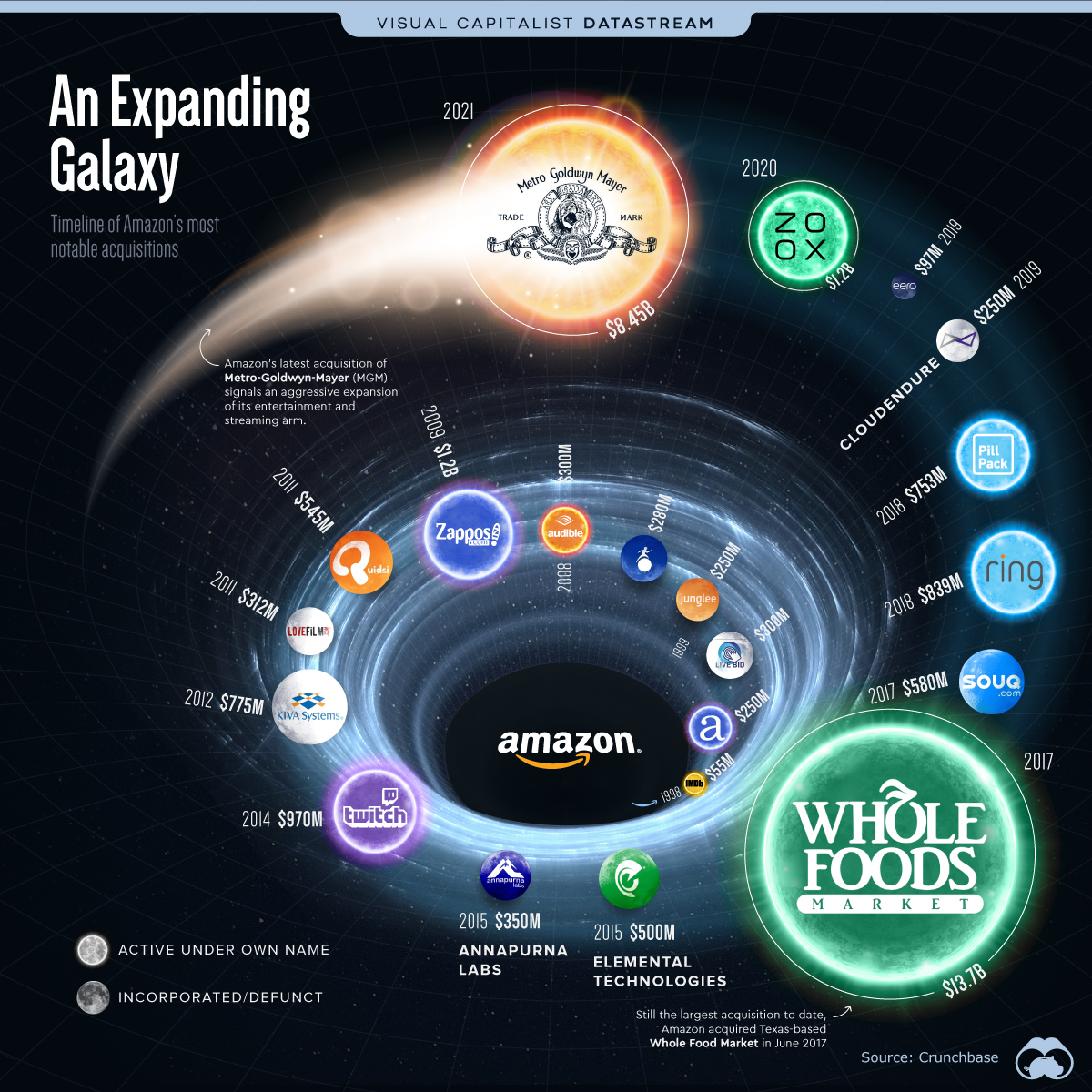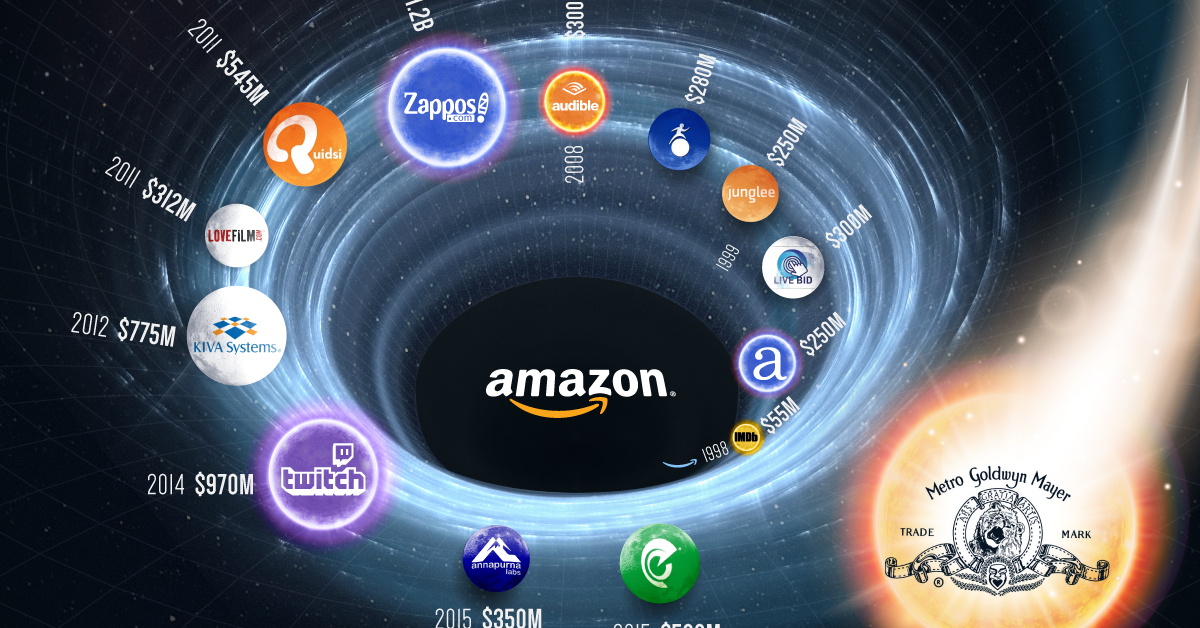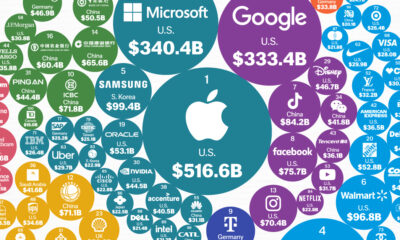Datastream
Amazon’s Most Notable Acquisitions to Date

The Briefing
- Amazon plans to acquire Metro-Goldwyn-Mayer (MGM) for $8.45 billion
- This move would add 4,000 films and 17,000 TV shows to Amazon Studios’ content library
Amazon’s Most Notable Acquisitions To Date
Big Tech just keeps getting bigger.
On May 26, 2021, Amazon announced its plan to acquire Metro-Goldwyn-Mayer (MGM) studios for $8.45 billion, making it the company’s second largest acquisition to date.
Amazon has acquired multiple companies across a variety of sectors from healthcare to entertainment, helping diversify its core revenue. In total, the tech giant has acquired or invested in over 128 different companies over the last 20 years.
Top 10 Amazon Acquisitions by Value
In 2017, Amazon paid $13.7 billion to purchase Whole Foods Market—this remains the company’s largest acquisition to date.
The Whole Foods acquisition provided brick-and-mortar space for Amazon to sell some of its flagship devices, like the Echo Dot. It also allowed Amazon to gather valuable shopping data on its customers, to better understand their offline shopping preferences.
Here’s how Amazon’s top 10 acquisitions by value stack up in comparison:
| Rank | Company Acquired | Announced Date | Acquisition Value |
|---|---|---|---|
| #1 | Whole Foods Market | Jun 16, 2017 | $13.7 billion |
| #2 | Metro-Goldwyn-Mayer | May 26, 2021 | $8.5 billion |
| #3 | Zoox | Jun 26, 2020 | $1.2 billion |
| #4 | Zappos | Jul 22, 2009 | $1.2 billion |
| #5 | Ring | Feb 27, 2018 | $970 million |
| #6 | PillPack | Jun 28, 2018 | $839 million |
| #7 | Twitch | Aug 25, 2014 | $775 million |
| #8 | Kiva Systems | Mar 19, 2012 | $753 million |
| #9 | Souq | Mar 27, 2017 | $580 million |
| #10 | Quidsi | Nov 8, 2010 | $545 million |
Prior to Wednesday’s announcement, the purchase of robotaxi company Zoox was Amazon’s second largest acquisition. According to their reported agreement, Amazon has the rights to use Zoox’s transport technology for ride-hailing or logistics (delivery) services.
The acquisition of MGM will add 21,000 films and TV shows to Amazon’s content library, helping Amazon keep up with the fierce competition in the content streaming industry. MGM owns the rights to “The Handmaid’s Tale” series and “Shark Tank,” as well as the James Bond and Rocky franchises.
Full List: Amazon’s Most Notable Acquisitions
While far from exhaustive, here’s a look at some of Amazon’s most notable acquisitions since 1998, as shown in the graphic:
| Year | Company Acquired | Acquisition Value | Post-Acquisition Status |
|---|---|---|---|
| 1998 | IMDb | $55,000,000 | Active under own name |
| 1999 | LiveBid.com | $300,000,000 | Incorporated/defunct |
| 1999 | PlanetAll | $280,000,000 | Incorporated/defunct |
| 1999 | Alexa Internet | $250,000,000 | Active under own name |
| 1999 | Junglee | $250,000,000 | Incorporated/defunct |
| 2008 | Audible | $300,000,000 | Active under own name |
| 2009 | Zappos | $1,200,000,000 | Active under own name |
| 2010 | Quidsi | $545,000,000 | Incorporated/defunct |
| 2011 | LoveFilm | $312,000,000 | Incorporated/defunct |
| 2012 | Kiva Systems | $775,000,000 | Incorporated/defunct |
| 2014 | Twitch Interactive | $970,000,000 | Active under own name |
| 2015 | Elemental Technologies | $500,000,000 | Incorporated/defunct |
| 2015 | Annapurna Labs | $350,000,000 | Incorporated/defunct |
| 2017 | Whole Foods Market | $13,700,000,000 | Active under own name |
| 2017 | Souq.com | $580,000,000 | Incorporated/defunct |
| 2018 | Ring | $839,000,000 | Active under own name |
| 2018 | PillPack | $753,000,000 | Active under own name |
| 2019 | CloudEndure | $250,000,000 | Incorporated/defunct |
| 2019 | Eero | $97,000,000 | Incorporated/defunct |
| 2020 | Zoox | $1,200,000,000 | Active under own name |
| 2021 | Metro-Goldwyn-Mayer | $8,450,000,000 | Active under own name |
»Like this? Then you might enjoy this full length article on the Biggest Tech Mergers and Acquisitions of 2020
Where does this data come from?
Source: Crunchbase
Notes: Values are in $USD, non-inflation adjusted
Datastream
Can You Calculate Your Daily Carbon Footprint?
Discover how the average person’s carbon footprint impacts the environment and learn how carbon credits can offset your carbon footprint.

The Briefing
- A person’s carbon footprint is substantial, with activities such as food consumption creating as much as 4,500 g of CO₂ emissions daily.
- By purchasing carbon credits from Carbon Streaming Corporation, you can offset your own emissions and fund positive climate action.
Your Everyday Carbon Footprint
While many large businesses and countries have committed to net-zero goals, it is essential to acknowledge that your everyday activities also contribute to global emissions.
In this graphic, sponsored by Carbon Streaming Corporation, we will explore how the choices we make and the products we use have a profound impact on our carbon footprint.
Carbon Emissions by Activity
Here are some of the daily activities and products of the average person and their carbon footprint, according to Clever Carbon.
| Household Activities & Products | CO2 Emissions (g) |
|---|---|
| 💡 Standard Light Bulb (100 watts, four hours) | 172 g |
| 📱 Mobile Phone Use (195 minutes per day)* | 189 g |
| 👕 Washing Machine (0.63 kWh) | 275 g |
| 🔥 Electric Oven (1.56 kWh) | 675 g |
| ♨️ Tumble Dryer (2.5 kWh) | 1,000 g |
| 🧻 Toilet Roll (2 ply) | 1,300 g |
| 🚿 Hot Shower (10 mins) | 2,000 g |
| 🚙 Daily Commute (one hour, by car) | 3,360 g |
| 🍽️ Average Daily Food Consumption (three meals of 600 calories) | 4,500 g |
| *Phone use based on yearly use of 69kg per the source, Reboxed | |
Your choice of transportation plays a crucial role in determining your carbon footprint. For instance, a 15 km daily commute to work on public transport generates an average of 1,464 g of CO₂ emissions. Compared to 3,360 g—twice the volume for a journey the same length by car.
By opting for more sustainable modes of transport, such as cycling, walking, or public transportation, you can significantly reduce your carbon footprint.
Addressing Your Carbon Footprint
One way to compensate for your emissions is by purchasing high-quality carbon credits.
Carbon credits are used to help fund projects that avoid, reduce or remove CO₂ emissions. This includes nature-based solutions such as reforestation and improved forest management, or technology-based solutions such as the production of biochar and carbon capture and storage (CCS).
While carbon credits offer a potential solution for individuals to help reduce global emissions, public awareness remains a significant challenge. A BCG-Patch survey revealed that only 34% of U.S. consumers are familiar with carbon credits, and only 3% have purchased them in the past.
About Carbon Streaming
By financing the creation or expansion of carbon projects, Carbon Streaming Corporation secures the rights to future carbon credits generated by these sustainable projects. You can then purchase these carbon credits to help fund climate solutions around the world and compensate for your own emissions.
Ready to get involved?
>> Learn more about purchasing carbon credits at Carbon Streaming
-

 Real Estate2 weeks ago
Real Estate2 weeks agoVisualizing America’s Shortage of Affordable Homes
-

 Technology1 week ago
Technology1 week agoRanked: Semiconductor Companies by Industry Revenue Share
-

 Money1 week ago
Money1 week agoWhich States Have the Highest Minimum Wage in America?
-

 Real Estate1 week ago
Real Estate1 week agoRanked: The Most Valuable Housing Markets in America
-

 Business2 weeks ago
Business2 weeks agoCharted: Big Four Market Share by S&P 500 Audits
-

 AI2 weeks ago
AI2 weeks agoThe Stock Performance of U.S. Chipmakers So Far in 2024
-

 Misc2 weeks ago
Misc2 weeks agoAlmost Every EV Stock is Down After Q1 2024
-

 Money2 weeks ago
Money2 weeks agoWhere Does One U.S. Tax Dollar Go?


















